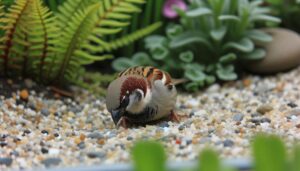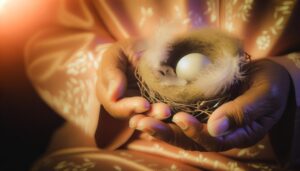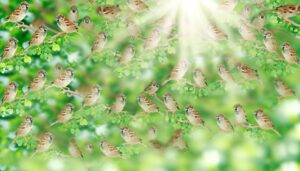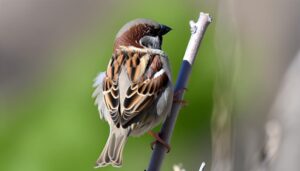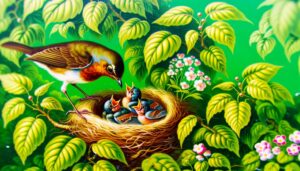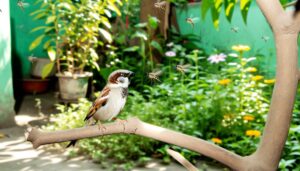House Sparrow Bird Egg Identification Chart: 3 Key Features
House Sparrow eggs exhibit a smooth and shiny surface, varying in color from white to grayish with speckles of brown or black. Typically, these eggs measure around 20mm in length and 15mm in width, with an oval shape that tapers slightly at one end, promoting efficient incubation.
The pigmentation patterns, which range from solid colors to intricate speckles, serve as camouflage against predators. Their nesting sites include building eaves, tree hollows, and other crevices.
The incubation period spans 10 to 14 days, primarily undertaken by the female. Understanding these characteristics can enhance your identification skills in the field.

Key Takeaways
- House Sparrow eggs are smooth, shiny, and vary in color from white to grayish with speckles of brown or black.
- The eggs measure approximately 20mm in length and 15mm in width, with an oval shape tapering at one end.
- Color variations include white to light green with distinctive brown or black speckles, influenced by genetics and environment.
- Nesting sites include building eaves, tree hollows, and urban structures, using materials like grass and feathers.
- The incubation period is 10 to 14 days, with females maintaining temperature and humidity.
Appearance of House Sparrow Eggs
House Sparrow eggs typically exhibit a smooth, shiny surface and vary in color from white to grayish with speckles of brown or black. These eggs' pigmentation serves as a camouflage mechanism, blending into the nesting environment to protect against predators.
The speckling pattern can differ significantly between eggs, showing a range of densities and distributions of the brown or black spots. This variability is thought to be influenced by both genetic factors and environmental conditions during egg formation.
The eggshell's glossy finish is attributed to the presence of a cuticle layer, which also plays a role in reducing water loss and providing additional protection against bacterial invasion.
Understanding these characteristics is essential for accurate identification and study of House Sparrow reproductive biology.
Size and Shape of Eggs
Although individual variations exist, the eggs of the House Sparrow typically measure about 20 millimeters in length and 15 millimeters in width, exhibiting an oval shape that tapers slightly at one end.
This size and shape are consistent with many small passerine birds, facilitating efficient incubation and best heat distribution. The oval form allows for stability within the nest, minimizing the risk of rolling and subsequent damage.
The dimensions are essential for species identification and provide insight into the reproductive strategies of the House Sparrow. By maintaining a consistent size and shape, these eggs guarantee proper embryonic development, reflecting evolutionary adaptations to their specific nesting environments and parental care behaviors.
Egg Color Variations
Egg color variations in house sparrows exhibit a range of common color patterns, typically spanning shades of white, gray, and light green. These eggs often feature distinctive markings and speckles which can aid in identification, with variations in density and distribution.
Additionally, seasonal changes may influence the pigmentation, resulting in subtle shifts in egg coloration throughout the breeding period.
Common Color Patterns
The coloration of house sparrow eggs typically ranges from white to pale gray, often speckled with fine brown or gray markings that provide camouflage and protection. These color variations are influenced by genetic factors and environmental conditions, ensuring best concealment from predators.
The base color, mainly white to gray, serves as a neutral backdrop, while the speckling pattern adds complexity to the egg's appearance, mimicking natural substrates such as twigs and leaves. This adaptive coloration enhances the chances of the eggs blending into their surroundings, thereby reducing predation risks.
Understanding these common color patterns is essential for accurate identification, as they are key indicators of the house sparrow's reproductive strategies and ecological adaptations.
Markings and Speckles
Markings and speckles on house sparrow eggs exhibit a range of patterns, typically consisting of fine brown or gray speckles distributed unevenly across the egg's surface, contributing to their camouflage and species identification. These speckles vary in density and distribution, which can help ornithologists and bird enthusiasts differentiate between eggs. The speckles' coloration and pattern are essential for the eggs' concealment from predators, blending seamlessly with the nesting environment.
| Egg Color Base | Speckle Color | Speckle Distribution |
|---|---|---|
| Light Blue | Brown | Evenly Spread |
| Pale Cream | Gray | Concentrated at Ends |
| Off-White | Brown-Gray | Uniformly Scattered |
This table summarizes common variations, aiding in accurate identification and understanding of house sparrow egg characteristics.
Seasonal Color Changes
Throughout the breeding season, house sparrow egg coloration may exhibit subtle variations influenced by environmental factors such as temperature and humidity. These variations can manifest as changes in the intensity of the base color, which typically ranges from white to pale gray or light green.
Higher temperatures often result in lighter egg colors, while increased humidity can enhance the prominence of speckles and markings. Seasonal shifts in vegetation and diet may also contribute to these color changes, as the pigmentation process is influenced by nutrient availability.
Understanding these variations is vital for accurate egg identification and monitoring, providing insights into the reproductive strategies and environmental adaptability of house sparrows.
Nest Locations
House Sparrows exhibit a wide range of nesting locations, often favoring common sites such as building eaves, crevices, and tree hollows.
A comparative analysis of urban versus rural nesting preferences reveals significant behavioral adaptations to different environments.
Additionally, seasonal nesting patterns influence nest site selection, with variations observed in response to climatic and ecological factors.
Common Nesting Sites
Common nesting sites for House Sparrows include a variety of sheltered locations such as eaves, vents, and nest boxes, where they can find protection from predators and harsh weather conditions.
These birds exhibit a high degree of adaptability, often utilizing human-made structures to their advantage. They are known to nest in crevices, building facades, and even agricultural equipment.
Additionally, House Sparrows may occupy cavities in trees or dense vegetation, although such choices are less common. Their nests are typically constructed from grass, feathers, and other soft materials, forming a compact, insulated environment.
Understanding these preferred nesting sites is essential for proper identification and conservation efforts, as it highlights the bird's reliance on both natural and artificial structures for reproductive success.
Urban Vs. Rural
Urban and rural environments present distinct nesting opportunities for House Sparrows, influencing their selection of nesting sites based on the availability of resources and shelter. In urban areas, House Sparrows frequently nest in man-made structures, exploiting architectural crevices and cavities. Conversely, rural environments offer more natural nesting sites, such as tree hollows and dense shrubbery.
The differences in nesting locations can be summarized as follows:
- Urban Nest Sites: Mainly in buildings, under eaves, and in ventilation ducts.
- Rural Nest Sites: Primarily in barns, tree cavities, and thick hedgerows.
- Resource Availability: Urban areas provide abundant food from human activities, while rural areas offer natural sources like seeds and insects.
Understanding these preferences aids in effective conservation strategies.
Seasonal Nesting Patterns
Seasonal variations greatly influence the nesting patterns of House Sparrows, dictating their choice of nest locations and affecting reproductive success.
During spring and summer, House Sparrows exhibit a preference for building nests in sheltered environments such as eaves, roof cavities, and building crevices. These locations provide protection against predators and adverse weather conditions, optimizing conditions for egg incubation and chick rearing.
Conversely, in autumn and winter, the availability of suitable nesting sites diminishes, and sparrows may resort to less ideal locations, including dense vegetation or unused structures.
The seasonal shifts in nest site selection are closely tied to fluctuations in environmental factors, food resources, and predator pressures, underscoring the adaptive strategies of House Sparrows in varied climatic conditions.
Egg Incubation Period
The incubation period for House Sparrow eggs typically ranges from 10 to 14 days. During this time, the female primarily assumes the role of maintaining ideal temperature and humidity for embryonic development. This critical phase ensures the eggs are kept at approximately 37.5°C (99.5°F), promoting the best growth conditions.
The female's behavior during incubation includes:
- Positioning: Regularly rotating the eggs to guarantee uniform heat distribution and prevent the embryo from adhering to the shell.
- Thermoregulation: Adjusting her body position and feathers to regulate the heat transferred to the eggs.
- Humidity Control: Balancing moisture levels by adjusting her nest materials and utilizing her own body's hydration.
These behaviors are essential for the successful hatching of the House Sparrow's offspring.
Common Egg Predators
While the meticulous incubation behaviors of the female House Sparrow are essential for embryonic development, these efforts are often threatened by a variety of common egg predators. Predatory birds such as jays and crows frequently raid nests, preying on the vulnerable eggs.
Mammalian threats include raccoons, squirrels, and domestic cats, all of which possess the agility and dexterity to access sparrow nests. Additionally, snakes, particularly those adept at climbing, pose significant risks to eggs in both urban and rural environments.
Even ants can be potential threats, especially in warmer climates where they are more active. These predators collectively pose a substantial threat to the reproductive success of House Sparrows, necessitating vigilant nest protection and strategic nesting site selection.
Observing and Documenting Eggs
Accurately observing and documenting House Sparrow eggs requires a systematic approach involving careful visual examination and detailed note-taking on egg characteristics such as color, size, shape, and markings.
Facilitating precise documentation will aid in the reliable identification and study of these eggs. To achieve this, consider the following steps:
- Visual Examination: Inspect the eggs under natural light to note their color, which typically ranges from white to pale gray, often speckled with brown or gray markings.
- Measurements: Use calipers to measure the dimensions of the eggs, making sure to record the length and width accurately.
- Photographic Evidence: Capture high-resolution photographs from multiple angles to document the eggs' appearance thoroughly.
This methodical approach ensures thorough and accurate egg identification.
Conclusion
In sum, the intricate characteristics of the house sparrow's eggs—ranging from their varied colors and specific sizes to their preferred nesting sites—underscore the complexity of avian reproduction.
Understanding these details illuminates the broader ecological dynamics at play and highlights the importance of meticulous observation.
The vigilance required to protect these eggs from common predators further emphasizes the delicate balance in avian ecosystems.
This knowledge not only enriches ornithological study but also fosters greater appreciation for avian biodiversity.

